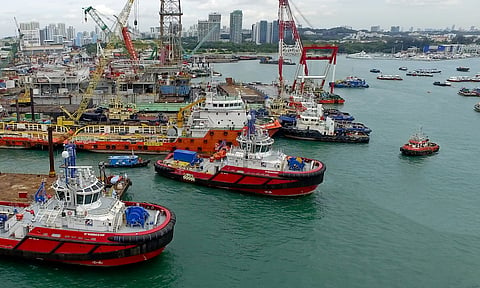

Despite the financial and geopolitical turmoil of the past decade, the tug and salvage sector has steamed on relentlessly. New, innovative and ever more powerful and easily operated tugs are delivered seemingly weekly.
In this era of rumoured orders for 23,000- or even 25,000TEU container ships, the need for ever more powerful, versatile and manoeuvrable harbour tugs is obvious. Despite their powerful side thrusters, such large ships require tugs to be available to support them in harbour. So, too, do the ever-larger cruise ships with their comparatively shallow draught and enormous windage. The recent accident in Venice highlighted that problem.
Even among smaller ships, with competent crews being increasingly difficult to recruit, tugs are ever more in demand, sometimes "just in case". Many ports, such as Venice and large numbers in the United States, require the use of escort tugs for many types of ships. They have to be sufficiently powerful to cope with the largest expected ships and then some.
Tankers, bulkers and gas tankers, with their mostly single engines and, usually, no thrusters, require tugs, often several tugs, whenever they arrive in or depart a port. They usually cannot berth or un-berth without them.
The whole maritime business grows steadily in terms of the sizes of ships. This seemingly endless progression ensures continuing growth in the global tug market. So, also, does the requirement for reduced maintenance, lower fuel consumption, lower emissions, absolute reliability and smaller crews in tugs. Modern port managers and ship owners demand that tugs be available 24/7.
Meanwhile the use of tug and barge combinations continues to grow practically everywhere. The versatility and comparatively low-cost of tug and barge operations is very appealing in many areas, especially where open ocean transits are not required. Usually, comparatively simple, shaft drive tugs are used with barges but lately even that sector has become more sophisticated with Z-drive tugs being gradually introduced.
Push tugs are always in demand and are increasingly powerful. Some of the big river and canal "tows" are enormous with Panamax loads of up to 65,000 tonnes in 16 or 20 barge "trains" being relatively common. The power and electronic sophistication of such tugs can be very impressive.
Now, with the ever-increasing use of Arctic waters for a whole lot of reasons, specialised ice-breaking tugs are becoming more common. Several have been launched recently, mainly in Russia and Finland, and more are in the offing.
Of course, much as most of us, except salvors, might wish otherwise, the requirement for salvage tugs remains. There are more ships so, inevitably, more ships get into trouble of various kinds. They require the assistance of salvage tugs and they require it fast.
While there is still a demand occasionally for large and very powerful salvage tugs, most such jobs are now handled by offshore service vessels in the form of anchor handling tugs. For day-to-day salvage jobs, harbour tugs are usually sufficient.
The leading tug naval architects, and they are usually specialised tug design firms, continue to improve the breed as do the often specialised tug builders. Those designers and builders are supported by the engine and propulsion system manufacturers, which strive to produce more powerful, more reliable, more economical and cleaner engines and more practical and useful propulsion systems. So, too, do the deck equipment and electronics manufacturers support the tug designers and builders.
The tug and salvage sector is a fascinating and exciting one. It exhibits almost constant innovation in all aspects of tug design, construction, power, propulsion, electronics, winches and safety equipment. Regular readers of Work Boat World will be well aware of most of this. However, we will be presenting far more than usual information over the coming week or so in this Tug and Salvage Feature Week. We trust that you find it interesting, useful and entertaining.
